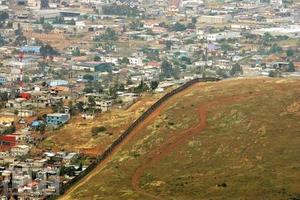Questions raised about wisdom of erecting a fence on Otay Mountain
DHS has spent $57.7-million – and waived more than thirty environmental laws in 2008 — to build a 3.6 mile fence on Otay Mountain; critics question the cost, effectiveness and environmental effect of erecting a fence where those who hiked three days up a steep, arid peak were often met by border agents anyway

The fence over Otay Mountain // Source: www.life.com
The border barrier dips and curves, hugging the mountain’s contours in a that reminds some of a slimmed-down version of the Great Wall of China. Among the costliest stretch of fencing ever built on the U.S.-Mexico border, the 3.6-mile wall of steel completed last fall is meant to block trafficking routes over Otay Mountain, just east of San Diego.
People seeking to enter the country illegally have hiked the scrub-covered, tarantula-infested peak for years, trying to get to roads leading to San Diego. “We’re no longer conceding this area to smugglers,” said Jerome Conlin, a U.S. Border Patrol spokesman.
Los Angeles Times’s Richard Marosi writes that critics are bewildered. Why, they ask, would people determined to scale a rugged, 3,500-foot peak be deterred by an 18-foot-high fence? They also point out that DHS deemed it unnecessary in 2006. “I think it’s a Bush-era boondoggle that will have almost no consequence in terms of stemming the flow of immigration,” said Char Miller, director of the environmental analysis program at Pomona College. “It was a political decision that took in no account of the environment itself, and in the process damages what was once a pretty remarkable landscape.”
The $57.7-million project is one segment in the massive expansion of border infrastructure approved by Congress during George W. Bush’s presidency. DHS has erected fencing in small towns, remote valleys, and high-desert mesas from the Pacific Ocean to Texas.
Marosi notes that the U.S. Government Accountability Office (GAO) determined that at about $16 million a mile, the Otay Mountain barrier cost about four times as much as similar border fencing built during this expansion.
The Border Patrol’s San Diego sector was already one of the U.S.’s most heavily fortified frontiers before the mountain fence was constructed, with about 40 of the sector’s 60 miles lined with vehicle or pedestrian barriers.
The fencing shifted immigrant flows to remote areas in the backcountry east of San Diego, but some migrants decided to climb Otay Mountain because of its proximity to a warehouse district in San Diego and its easy access on the Mexican side, where the Tijuana-Tecate toll road lies only a few hundred yards away.
Marosi writes that immigrants dropped off at staging grounds off the toll road headed up steep trails into the United States. Their hikes through canyons and over the arid peak could take up to three days. With limited road access on the mountain, agents simply waited for
